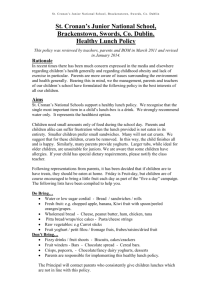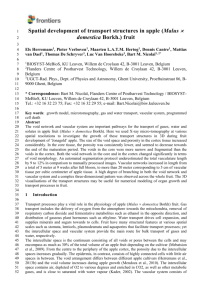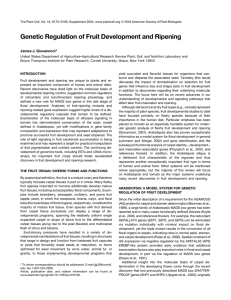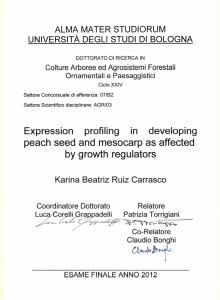tpj12094-sup-0012-Legends
advertisement
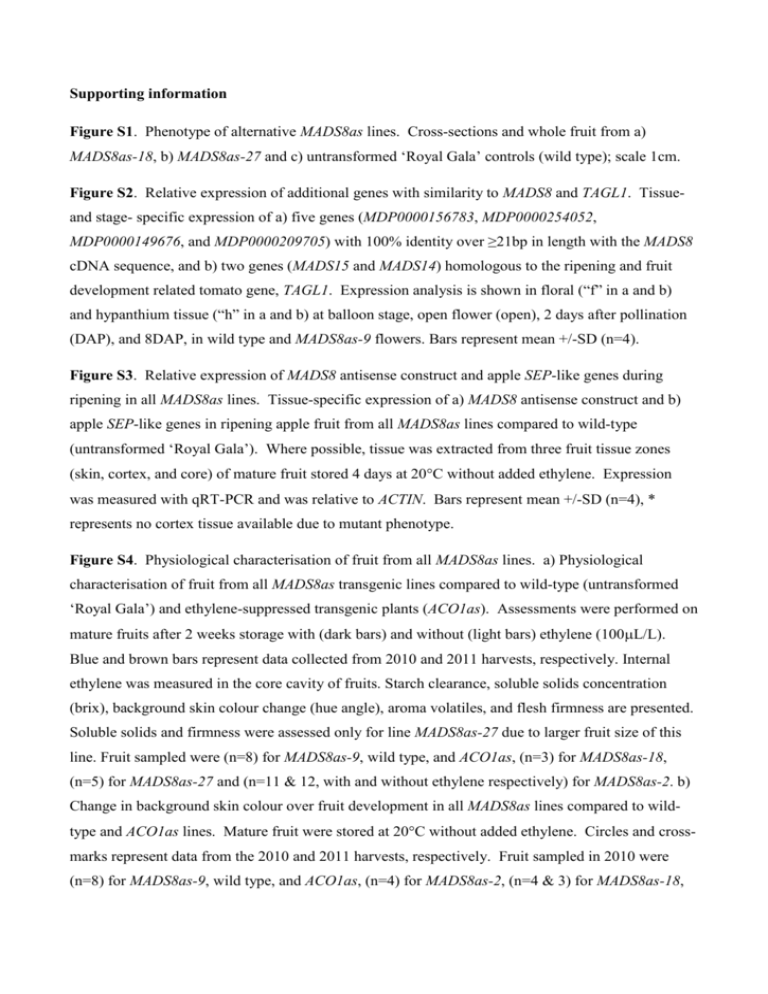
Supporting information Figure S1. Phenotype of alternative MADS8as lines. Cross-sections and whole fruit from a) MADS8as-18, b) MADS8as-27 and c) untransformed ‘Royal Gala’ controls (wild type); scale 1cm. Figure S2. Relative expression of additional genes with similarity to MADS8 and TAGL1. Tissueand stage- specific expression of a) five genes (MDP0000156783, MDP0000254052, MDP0000149676, and MDP0000209705) with 100% identity over ≥21bp in length with the MADS8 cDNA sequence, and b) two genes (MADS15 and MADS14) homologous to the ripening and fruit development related tomato gene, TAGL1. Expression analysis is shown in floral (“f” in a and b) and hypanthium tissue (“h” in a and b) at balloon stage, open flower (open), 2 days after pollination (DAP), and 8DAP, in wild type and MADS8as-9 flowers. Bars represent mean +/-SD (n=4). Figure S3. Relative expression of MADS8 antisense construct and apple SEP-like genes during ripening in all MADS8as lines. Tissue-specific expression of a) MADS8 antisense construct and b) apple SEP-like genes in ripening apple fruit from all MADS8as lines compared to wild-type (untransformed ‘Royal Gala’). Where possible, tissue was extracted from three fruit tissue zones (skin, cortex, and core) of mature fruit stored 4 days at 20C without added ethylene. Expression was measured with qRT-PCR and was relative to ACTIN. Bars represent mean +/-SD (n=4), * represents no cortex tissue available due to mutant phenotype. Figure S4. Physiological characterisation of fruit from all MADS8as lines. a) Physiological characterisation of fruit from all MADS8as transgenic lines compared to wild-type (untransformed ‘Royal Gala’) and ethylene-suppressed transgenic plants (ACO1as). Assessments were performed on mature fruits after 2 weeks storage with (dark bars) and without (light bars) ethylene (100L/L). Blue and brown bars represent data collected from 2010 and 2011 harvests, respectively. Internal ethylene was measured in the core cavity of fruits. Starch clearance, soluble solids concentration (brix), background skin colour change (hue angle), aroma volatiles, and flesh firmness are presented. Soluble solids and firmness were assessed only for line MADS8as-27 due to larger fruit size of this line. Fruit sampled were (n=8) for MADS8as-9, wild type, and ACO1as, (n=3) for MADS8as-18, (n=5) for MADS8as-27 and (n=11 & 12, with and without ethylene respectively) for MADS8as-2. b) Change in background skin colour over fruit development in all MADS8as lines compared to wildtype and ACO1as lines. Mature fruit were stored at 20C without added ethylene. Circles and crossmarks represent data from the 2010 and 2011 harvests, respectively. Fruit sampled in 2010 were (n=8) for MADS8as-9, wild type, and ACO1as, (n=4) for MADS8as-2, (n=4 & 3) for MADS8as-18, (n=5) for MADS8as-27. Fruit sampled in 2011 were (n=10) for wild type and (n=12) for MADS8as9 and MADS8as-2. Figure S5. Relative expression of ripening-marker genes in fruit from all MADS8as lines. Tissuespecific expression of ripening-marker genes in ripening apple fruit from all MADS8as lines compared to wild type (untransformed ‘Royal Gala’). Where possible, tissue was extracted from three zones (skin, cortex, and core) of mature fruit stored 4 days at 20C with and without added ethylene. Expression was measured with qRT-PCR and was relative to ACTIN. Bars represent mean +/-SD (n=4), * represents no cortex tissue available due to mutant phenotype. Figure S6. Nucleotide alignment of the MADS8as transgene from lines exhibiting the mutant phenotype. Nucleotide alignment was prepared in Geneious Pro 5.5.6 (Biomatters) upon the sequenced transgene resident in three transgenic lines exhibiting the mutant phenotype: MADS8as-9, -2, and -18. The sequence for MADS8as-27 was not included due to the wild-type phenotype of this line. Table S1. Genomic locations of apple SEP-like genes as determined by the draft apple genome. Table S2. GenBank accession numbers for MADS-box proteins included in the phylogenetic tree. MDP numbers are for apple gene models available from the Genome Database for Rosaceae (www.rosaceae.org). Table S3. Predicted apple gene models and genomic regions with similarity to MADS8 cDNA. Models and regions with similarity to MADS8 cDNA have the potential to be targeted for suppression by the MADS8as transgene. a) Predicted apple gene models with significant similarity to MADS8 cDNA sequence. Similarity classed as greater than 100bp in length and greater than 85% pairwise identity. b) Apple genomic regions with significant similarity to MADS8 cDNA sequence. Regions identified had one or many regions of 21bp or greater with 100% pairwise identity. Table S4. Primer sequences used in qRT-PCR experiments.




